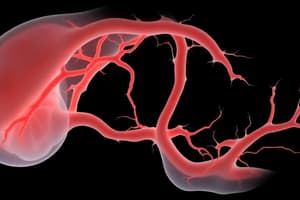Podcast
Questions and Answers
What anatomical structures contribute to the formation of the left subclavian artery?
What anatomical structures contribute to the formation of the left subclavian artery?
- Left branch of pulmonary artery
- Left dorsal aorta (correct)
- Left 7th inter-segmental artery (correct)
- Left 4th aortic arch
Which condition is characterized by the ductus arteriosus remaining open?
Which condition is characterized by the ductus arteriosus remaining open?
- Pulmonary atresia
- Aortic coarctation
- Fallot’s tetralogy
- Patent ductus arteriosus (correct)
In which type of aortic coarctation is the constriction proximal to the ductus arteriosus entrance?
In which type of aortic coarctation is the constriction proximal to the ductus arteriosus entrance?
- Distal coarctation
- Post-ductal coarctation
- Pre-ductal coarctation (correct)
- Proximal coarctation
What percentage of congenital heart disease cases involves aortic coarctation?
What percentage of congenital heart disease cases involves aortic coarctation?
What is a common feature of both types of aortic coarctation?
What is a common feature of both types of aortic coarctation?
What structure is formed from the right horn of the aortic sac?
What structure is formed from the right horn of the aortic sac?
Which of the following is the fate of the 5th aortic arch?
Which of the following is the fate of the 5th aortic arch?
The left horn of the aortic sac contributes to which structure?
The left horn of the aortic sac contributes to which structure?
What does the 3rd aortic arch develop into?
What does the 3rd aortic arch develop into?
Which aortic arch gives rise to the stapedial artery?
Which aortic arch gives rise to the stapedial artery?
What structure does the distal part of the right 6th aortic arch form?
What structure does the distal part of the right 6th aortic arch form?
The left recurrent laryngeal nerve hooks around which structure?
The left recurrent laryngeal nerve hooks around which structure?
What does the right fourth aortic arch develop into?
What does the right fourth aortic arch develop into?
What is the primary formation site of the left subclavian artery?
What is the primary formation site of the left subclavian artery?
What characterizes aortic coarctation occurring distal to the ductus arteriosus?
What characterizes aortic coarctation occurring distal to the ductus arteriosus?
Which of the following is a common type of congenital heart disease associated with patent ductus arteriosus?
Which of the following is a common type of congenital heart disease associated with patent ductus arteriosus?
What is a characteristic of pre-ductal aortic coarctation?
What is a characteristic of pre-ductal aortic coarctation?
Which statement correctly describes the left 4th aortic arch?
Which statement correctly describes the left 4th aortic arch?
What structure does the aortic sac primarily develop into?
What structure does the aortic sac primarily develop into?
What does the 1st aortic arch give rise to?
What does the 1st aortic arch give rise to?
Which part develops from the left 6th aortic arch?
Which part develops from the left 6th aortic arch?
What is one of the fates of the 4th aortic arch on the left side?
What is one of the fates of the 4th aortic arch on the left side?
Which aortic arch degenerates completely?
Which aortic arch degenerates completely?
What is the role of the right horn of the aortic sac?
What is the role of the right horn of the aortic sac?
Which structure is formed cranial to the 3rd aortic arch?
Which structure is formed cranial to the 3rd aortic arch?
The common dorsal aorta is formed by the fusion of which structures?
The common dorsal aorta is formed by the fusion of which structures?
Flashcards are hidden until you start studying
Study Notes
Development of Arteries
- During the 4th and 5th weeks of development, the aortic sac forms, located distal to the truncus arteriosus.
- The aortic sac has right and left horns.
- The horns connect to the 1st aortic arch.
- The 1st aortic arches grow dorsal to the gut, forming the dorsal aortae.
- The two dorsal aortae fuse to form the common dorsal aorta.
- The remaining five aortic arches develop craniocaudally between the aortic sac and the dorsal aortae.
Fate of Structures
- Aortic Sac:
- The stem of the aortic sac forms the aortic arch proximal to the brachiocephalic artery.
- The right horn of the aortic sac forms the brachiocephalic artery.
- The left horn of the aortic sac forms the aortic arch between the brachiocephalic artery and the left common carotid.
- Aortic Arches:
- The 1st aortic arch forms the maxillary artery.
- The 2nd aortic arch forms the stapedial artery.
- The 3rd aortic arch forms the common carotid artery and the proximal part of the internal carotid artery.
- The external carotid appears as a bud.
- The 4th aortic arch:
- The right 4th aortic arch forms part of the right subclavian artery.
- The left 4th aortic arch forms the aortic arch between the left common carotid and left subclavian artery.
- The 5th aortic arch degenerates.
- The 6th aortic arch:
- The proximal part of the 6th aortic arch forms the pulmonary artery.
- The distal part of the 6th aortic arch degenerates on the right side.
- The distal part of the 6th aortic arch forms the ductus arteriosus on the left side.
- Dorsal Aorta:
- The cranial part (above the 3rd aortic arch) of the dorsal aorta forms the distal part of the internal carotid artery.
- The section between the 3rd and 4th aortic arches degenerates.
- From the 4th to 6th aortic arches:
- Right side forms the right subclavian artery.
- Left side forms the aortic arch distal to the subclavian artery.
- Distal to the 6th aortic arch:
- Right side forms the right subclavian artery until the 7th intersegmental artery.
- Left side forms the descending aorta.
- The left side degenerates distal to the 7th intersegmental artery.
Formation of Specific Arteries
- Aortic Arch: Formed of the following:
- Stem of the aortic sac (from origin to the brachiocephalic artery)
- Left horn of the aortic sac (from the brachiocephalic artery to the left common carotid artery)
- Left 4th aortic arch (from the left common carotid artery to the left subclavian artery)
- Left dorsal aorta (distal to the left subclavian artery)
- Subclavian Artery:
- Left: Formed by the left 7th intersegmental artery.
- Right: Formed from
- Right 4th aortic arch
- Right dorsal aorta between the 4th aortic arch and the right 7th intersegmental artery
- Right 7th intersegmental artery
Anomalies
- Patent Ductus Arteriosus (PDA):
- A common potential cyanotic heart disease.
- The duct between the left pulmonary artery branch and aortic arch remains open.
- May be accompanied by other diseases like Fallot's Tetralogy.
- Aortic Coarctation:
- Constriction of the aorta distal to the origin of the left subclavian artery.
- Occurs in 10% of congenital heart diseases.
- Types:
- Pre-ductal: Coarctation is proximal to the entrance of the ductus arteriosus, and the ductus remains open.
- Post-ductal: Coarctation is distal to the entrance of the ductus arteriosus, and the ductus usually closes. Collateral circulation develops.
Aortic Sac Development
- The aortic sac develops during weeks 4 and 5 of gestation and lies distal to the truncus arteriosus
- The aortic sac has right and left horns, continuous with the first aortic arch
- These horns grow dorsally (toward the back) to the gut, forming dorsal aortae
- The dorsal aortae fuse to create the common dorsal aorta
Aortic Arch Development
- Five additional aortic arches develop craniocaudally, between the aortic sac and dorsal aortae
- Fate of the aortic arches:
- First aortic arch: forms the maxillary arteries
- Second aortic arch: forms the stapedial arteries
- Third aortic arch: forms the common carotid arteries and the proximal parts of the internal carotid arteries
- Fourth aortic arch:
- The right arch contributes to the right subclavian artery
- The left arch contributes to the aortic arch between the left common carotid and left subclavian arteries
- Fifth aortic arch: degenerates
- Sixth aortic arch:
- The proximal portion forms both the left and right pulmonary arteries.
- The distal portion degenerates on the right side, forming the ductus arteriosus on the left side
Dorsal Aorta Development
- The cranial portion of the dorsal aorta, superior to the third aortic arch, develops into the distal portion of the internal carotid artery
- The portion of the dorsal aorta between the third and fourth aortic arches degenerates
- The dorsal aorta from the fourth to the sixth aortic arch contributes to the descending aorta
- The right and left sides of the dorsal aorta have different fates:
- Right side: Forms the right subclavian artery, extending to the seventh intersegmental artery
- Left side: Forms the aortic arch (distal to the subclavian), and the descending aorta. The left dorsal aorta degenerates distal to the seventh intersegmental artery
Aortic Arch Formation
- The aortic arch is formed from:
- The stem of the aortic sac (contributes from the origin to the brachiocephalic artery)
- The left horn of the aortic sac (contributes from the brachiocephalic artery to the left common carotid artery)
- The left fourth aortic arch (contributes from the left common carotid artery to the left subclavian artery)
- The left dorsal aorta (contributes distal to the left subclavian artery)
Subclavian Artery Formation
- The left subclavian artery is formed by the left seventh intersegmental artery
- The right subclavian artery is formed by:
- The right fourth aortic arch
- The right dorsal aorta between the fourth aortic arch and the right seventh intersegmental artery
- The right seventh intersegmental artery
Aortic Anomalies
- Patent ductus arteriosus:
- Occurs when the duct between the left branch of the pulmonary artery and the aortic arch remains patent.
- This is a common cause of cyanotic heart disease and can sometimes present with other conditions, such as Fallot’s tetralogy
- Aortic coarctation:
- This is a narrowing of the aorta distal to the origin of the left subclavian artery.
- It occurs in 10% of cases of congenital heart disease.
- Two types exist:
- Pre-ductal coarctation: The coarctation is proximal to the entrance of the ductus arteriosus (the duct remains open)
- Post-ductal coarctation: The coarctation is distal to the entrance of the ductus arteriosus (the duct typically closes). Collateral circulation develops.
Studying That Suits You
Use AI to generate personalized quizzes and flashcards to suit your learning preferences.




